Teeth Shaving: What Is It, Benefits, And Who Is a Candidate?

Table of Contents
- What Is Tooth Shaving?
- Purpose of Teeth Reshaping
- Benefits
- Risks
- Does Tooth Shaving Hurt?
- Cost
- Are You a Candidate?
- Should You Shave At Home?
- References
The process of teeth shaving goes by a variety of names: teeth contouring, teeth filling, teeth reshaping and teeth slenderizing. The goal is to fixed chipped teeth so that they are smooth and look good inside the mouth. Most of the time, teeth shaving is considered cosmetic and is not covered by insurance.
What Is Tooth Shaving?
While you may not have heard of the term tooth shaving, this procedure goes by many different names. These include teeth contouring, teeth filling, teeth reshaping and teeth slenderizing. However, the technical name for this procedure is enameloplasty, or ondotoplasty.
As the various names suggest, the procedure involves reducing the size of teeth slightly to improve their appearance and how they fit in your mouth. While dentists often perform tooth shaving for cosmetic reasons, there are time they recommend it because they find it to be necessary for medical reasons.
In most cases, people who seek out teeth contouring services want to smooth out a chipped or misshapen tooth. In such instances, the dentist will have to remove the mamelons or scalloped edges to create a smooth and even line.
The cost associated to reshaping multiple teeth and re-balancing your bite, referred to as occlusal equilibration, can range from $650 to $1,500.
Purpose of Teeth Reshaping
Some of the main reasons why people decide to have their teeth slenderized include:
Reshaping damaged teeth. If you've ever chipped a tooth, you might have found it hard to rest your tongue without being pricked. Tooth shaving removes sharp edges on your teeth, giving you a radiant smile and reducing the chances of hurting your tongue on the sharp edges.
Creating more room in your mouth. Crowded teeth can be uncomfortable and make it harder to execute certain oral procedures, like applying dental braces. With tooth reshaping, you can adjust overlapping teeth and get most dental procedures more easily.
Getting a better appearance. One of the major purposes of tooth shaving is for cosmetic and beauty reasons. You might feel that one tooth doesn't quite fit in with the rest and choose to have it filed down to match the others.
Adjusting your bite. Sometimes, you may feel like some teeth bite down hard while others don't touch completely. This misalignment can create sensitivity, jaw pain and recession. Tooth filing can help level your teeth, so everything balances off when you bite something.
Benefits of Teeth Filing
The chief benefits of teeth shaving are:
It is a fairly inexpensive procedure to improve the aesthetic appeal of your teeth and oral appearance.
There's little discomfort during the procedure since only the surface enamel is removed.
The procedure improves your oral hygiene since it removes places where plaque and tartar can build up and cause damage.
It's an effective alternative for other dental procedures, like braces, which may take a long time to shape your teeth.
Risks of Teeth Contouring
Since teeth shaving typically involves removing small bits of the enamel layer, the procedure doesn't carry significant risk. However, when you do the procedure at home or when a lot of the enamel layer is scraped off, it could lead to complications, such as tooth sensitivity.
More risks come into play if a dentist performs the procedure on an already damaged tooth. Your dentist ideally will advise you on the best possible solution to minimize and possibly eliminate any risk associated with the shaving procedure.
Does Tooth Shaving Hurt?
Many people are apprehensive about visiting a dentist because of pain and sensitivity from various procedures. But tooth shaving is pain-free because the filing process only affects the topmost layer of the teeth.
Because the dentist won't interfere with the tooth pulp or root, there's little-to-no chance of experiencing pain. In fact, many patients go through the shaving procedure without requiring any anesthetic.
How Much Does Tooth Shaving Cost?
Relative to other dental procedures, tooth filing is an inexpensive procedure. The exact price depends on your location, the dental practice and the extent of shaving required. Regardless, you should be able to get the procedure done for $50 to $350 per tooth.
Some factors can drive up the cost. For example, you may have to pay more if you need several teeth to be ground down to a level where you can comfortably bite with most of the teeth.
Some teeth shaving costs may be covered by your insurance provider but only if the procedure is not cosmetic. If the procedure is medical, your insurance may cover the entire cost. Your dentist may have to help you to get insurance to cover the costs during a pre-approval process.
Are You a Candidate for Teeth Shaving?
To qualify for the tooth filling procedure, you need to have a chipped or rough-edged teeth. If the teeth misalignment bothers you, then you can talk to your dentist about getting the procedure. If you have issues with biting or chewing food due to your teeth's size or alignment, you’re also a good candidate.
Should You Shave Your Teeth at Home?
Some people take teeth shaving into their own hands. This is not a good idea. You could end up unearthing severe oral and dental complications by doing the procedure yourself.
For example, if you DIY the teeth shaving process, you could end up shaving more than the top enamel layer. This will leave your teeth's pulp and root exposed, which could lead to sensitivity, cavities, infection and other complications.
